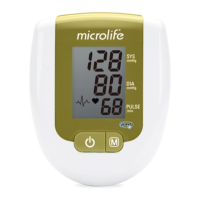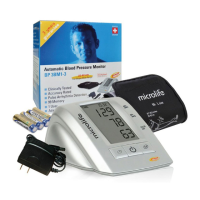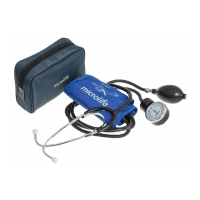2
Table of contents
1. Important facts about blood pressure
How do I evaluate my blood pressure
2. Using the device for the first time
Inserting the batteries
Selecting the correct cuff
3. Taking a blood pressure measurement
Checklist for taking a reliable measurement
4. Appearance of the irregular heartbeat (IHB) symbol
5. Data memory
Viewing the stored values
Memory full
Clearing all values
How not to store a reading
6. Battery indicator and battery change
Low battery
Flat battery - replacement
Which batteries and which procedure?
Using rechargeable batteries
7. Using a mains adapter
8. Error Messages
9. Safety, care, accuracy test and disposal
Device care
Cleaning the cuff
Accuracy test
Disposal
10. Guarantee
11. Technical Specifications
1. Important facts about blood pressure
Blood pressure is the pressure of the blood flowing in the
arteries generated by the pumping of the heart. Two values, the
systolic (upper) value and the diastolic (lower) value, are
always measured.
The device indicates the pulse rate (the number of times the
heart beats in a minute).
Permanently high blood pressure values can damage your
health and must be treated by your doctor!
Always discuss your values with your doctor and tell them if you
have noticed anything unusual or feel unsure. Never rely on
single blood pressure readings.
There are several causes of excessively high blood pressure
values. Your doctor will explain them in more detail and offer
treatment where appropriate.
Under no circumstances should you alter the dosages
of drugs or initiate a treatment without consulting your
doctor.
Depending on physical exertion and condition, blood pressure
is subject to wide fluctuations as the day progresses. You
should therefore take your measurements in the same
quiet conditions and when you feel relaxed! Take at least
two readings every time (in the morning: before taking medica-
tions and eating / in the evening: before going to bed, bathing
or taking medication) and average the measurements.
It is quite normal for two measurements taken in quick succes-
sion to produce significantly different results.
Deviations between measurements taken by your doctor or in
the pharmacy and those taken at home are quite normal, as
these situations are completely different.
Several measurements provide much more reliable informa-
tion about your blood pressure than just one single measure-
ment.
Leave a small break of >5 minutes between two measure-
ments.
If you suffer from a cardiac arrhythmia consult with your doctor
before using the device. See also chapter «Appearance of the
irregular heartbeat (IHB) symbol» of this user manual.
The pulse display is not suitable for checking the
frequency of heart pacemakers!
If you are pregnant, you should monitor your blood pressure
regularly as it can change drastically during this time.
How do I evaluate my blood pressure
Table for classifying blood pressure values in adults in accordance
with the World Health Organisation (WHO) in 2003. Data in mmHg.
Range Systolic Diastolic Recommendation
1. blood pressure
normal
< 120 < 80 Self-check
2. blood pressure
normal
120 - 129 80 - 84 Self-check
3. blood pressure
slightly high
130 - 139 85 - 89 Consult your
doctor
4. blood pressure
too high
140 - 159 90 - 99 Seek medical
advice

